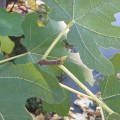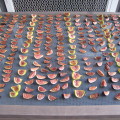Harvesting & Storage of Figs
Edible Parts of the Plant
Just the figs, as far as I know…
Yield
Harvest Timing
- figs are usually ready to pick in late summer
- according to “Backyard Harvest”, figs don’t ripen any more once they’re picked; however, Fine Cooking’s “In Season” states that underripe figs can be “coaxed” to ripen if left on the counter for a day or two
- they are ripe when they are hanging down from the tree (before they are ripe, they point upward)
- they should feel soft
- sap appearing at the base of the fruit is one source’s indication of ripeness
- overripe figs appear slumped, and often are resting on flattened sides – overripe figs have sometimes soured
Harvest Methods
- pick the fig carefully, trying not to bruise it
Storage of harvest
Fresh
- figs keep fresh for about a week, if stored in a cool place (refrigerate)
- store in a single layer, rather than in a basket or bowl
Canned
- whole figs can be cooked in a light sugar syrup for just a couple of minutes – you don’t even need to cut the stems off, then can in a waterbath
Frozen
- freeze figs in peak condition by trimming stems and halve or slice; spread on a tray to freeze then package in airtight container
Pickled
Dried
Cooking
Nutritional Benefits & Values
Toxicity
Cooking
Preparation
- the tender skin of figs doesn’t need to be peeled, unless there are rough or damaged patches, although slightly underripe figs have a thicker, white skin that could probably be peeled
- rinse away any dust that has gathered
Cooking Methods
- in general, figs can be eaten fresh, or split and stuffed with a salty cheese
- add them to salads
- use as a side dish with meat that carries a pan sauce
- bake them into bread or sweets
- roast with butter & sugar
- try in ice cream
Recipes (link to …/category/recipes/tag/[plantname])
Resources
Information for this article was taken from these sources. (link to …/category/resources/tag/[plantname])




